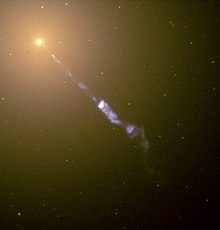Jet (fluid)
This article needs additional citations for verification. (September 2014) |

Jets from a pump-jet on a ferry.

A jet is a stream of fluid that is projected into a surrounding medium, usually from some kind of a nozzle, aperture or orifice.[1] Jets can travel long distances[quantify] without dissipating.
Jet fluid has higher momentum compared to the surrounding fluid medium. In the case that the surrounding medium is assumed to be made up of the same fluid as the jet, and this fluid has a viscosity, the surrounding fluid is carried along with the jet in a process called entrainment.[2]
Some animals, notably cephalopods, move by jet propulsion, as do rocket engines and jet engines.
See also[]
- Plane counterflow jets
- Bickley jet
- Landau–Squire jet
- Schlichting jet
- Jet nozzle, how a jet is formed
- Jet damping, a jet carries away angular momentum from a device emitting it
- Jet noise
- Jet of blood
- Astrophysical jet
- Lava fountain
References[]
- ^ "a usually forceful stream of fluid (as water or gas) discharged from a narrow opening or a nozzle." http://www.merriam-webster.com/dictionary/jet
- ^ Swain, Prakash Chandra (2016). "Fluid Dynamics Lecture Notes" (PDF). www.vssut.ac.in. Retrieved 26 July 2021.
- Pijush K. Kundu and Ira M. Cohen, "Fluid mechanics, Volume 10", Elsevier, Burlington, MA,USA (2008), ISBN 978-0-12-373735-9
- Falkovich, G. (2011). Fluid Mechanics, a short course for physicists. Cambridge University Press. ISBN 978-1-107-00575-4.
Categories:
- Fluid dynamics
- Fluid dynamics stubs